Fertile Crescent › Byzantine-Armenian Relations& › Pericles » Origins and History
Articles and Definitions › Contents
- Fertile Crescent › Origins
- Byzantine-Armenian Relations › Origins&
- Pericles › Who Was
Ancient civilizations › Historical places, and their characters
Fertile Crescent › Origins
Definition and Origins
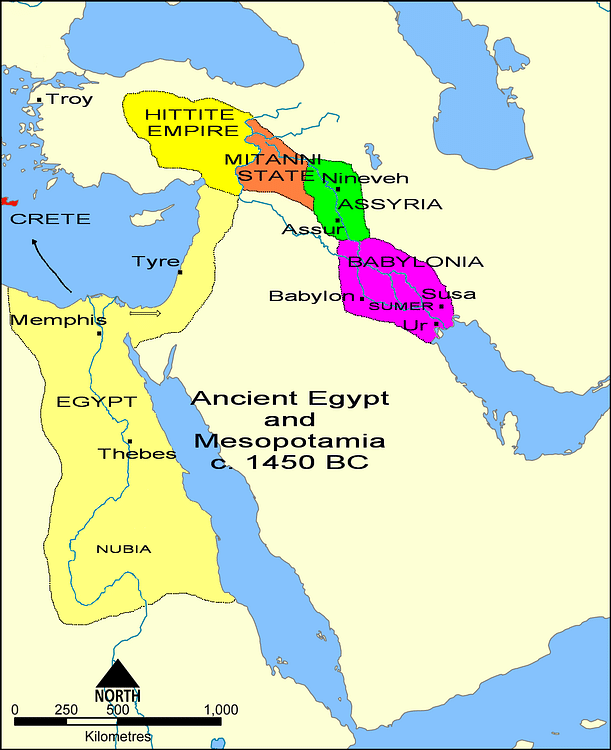
The Fertile Crescent, often called the "Cradle of Civilization ", is the region in the Middle East which curves, like a quarter-moon shape, from the Persian Gulf, through modern-day southern Iraq, Syria, Lebanon, Jordan, Israel and northern Egypt.The region has long been recognized for its vital contributions to world culture stemming from the civilizations of ancient Mesopotamia, Egypt, and the Levant which included the Sumerians, Babylonians, Assyrians, Egyptians, and Phoenicians, all of whom were responsible for the development of civilization.
Virtually every area of human knowledge was advanced by these people, including:
- Science and Technology
- Writing and Literature
- Religion
- Agricultural Techniques
- Mathematics and Astronomy
- Astrology and the Development of the Zodiac
- Domestication of Animals
- Long-Distance Trade
- Medical Practices (including dentistry)
- The Wheel
- The Concept of Time
The term was first coined in 1916 CE by the Egyptologist James Henry Breasted in his work Ancient Times: A History of the Early World, where he wrote:
This fertile crescent is approximately a semi-circle, with the open side toward the south, having the west end at the south-east corner of the Mediterranean, the centre directly north of Arabia, and the east end at the north end of the Persian Gulf. (193-194)
His phrase was widely circulated through the publications of the day becoming, finally, the common designation for this region.The Fertile Crescent is traditionally associated in the Jewish, Christian and Muslim faiths with the earthly location of the Garden of Eden. The area features prominently in the Bible and Quran and a number of sites there are associated with narratives from those works.
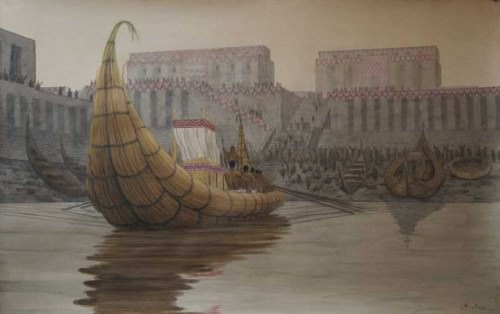
Representation of the Port of Eridu
CRADLE OF CIVILIZATION
Known as the Cradle of Civilization, the Fertile Crescent is regarded as the birthplace of agriculture, urbanization, writing, trade, science, history and organized religion and was first populated c. 10,000 BCE when agriculture and the domestication of animals began in the region. By 9,000 BCE the cultivation of wild grains and cereals was wide-spread and, by 5000 BCE, irrigation of agricultural crops was fully developed. By 4500 BCE the cultivation of wool-bearing sheep was practiced widely.
THE GEOGRAPHY & CLIMATE OF THE REGION WERE CONDUCIVE TO AGRICULTURE & HUNTER-GATHERER SOCIETIES SHIFTED TO SEDENTARY COMMUNITIES.
The geography and climate of the region were conducive to agriculture and hunter-gatherer societies shifted to sedentary communities in the area as they were able to support themselves from the land. The climate was semi-arid but the humidity, and proximity of the Tigris and Euphrates Rivers (and, further south, the Nile ), encouraged the cultivation of crops. Rural communities developed along with technological advances in agriculture and, once these were established, domestication of animals followed.
The first cities began to rise in Mesopotamia in the region of Sumer. Eridu, the first, according to the Sumerians, in 5400 BCE, then Uruk and others. By c. 4500 BCE cultivation of wheat and grains had long been practiced in addition to the further domestication of animals. By the year 3500 BCE the image of the breed of dog known as the Saluki was appearing regularly on vases and other ceramics as well as wall paintings along with breeds such as the Dane, Greyhound, and Mastiff.
The unusually fertile soil of the region encouraged the further cultivation of wheat as well as rye, barley, and legumes and some of the earliest beer in the world was brewed in the great cities along the Tigris and Euphrates Rivers under the auspices of the goddess Ninkasi. Beer was considered a gift from the gods and a source of daily nutrition as well as an intoxicant. It was used to pay people's wages but inscriptions also make clear it was brewed for celebratory purposes and the famous Hymn to Ninkasi praises the brew for making one's heart feel light.
This beer was quite different from that of the modern day as it was thick and had to be consumed with a straw to filter out residue from the fermenting process. Beer brewing probably evolved from the baker's craft as the barley and wheat they stored fermented. The most ancient evidence of beer brewing comes from the Sumerian outpost settlement of Godin Tepe in modern-day Iran.
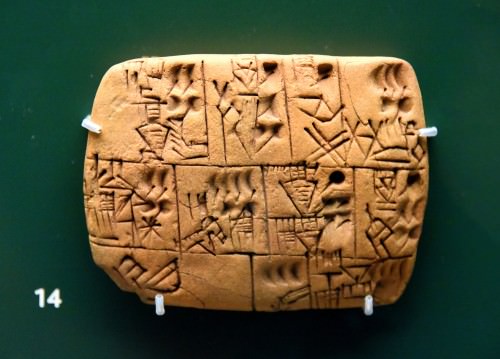
Mesopotamian Beer Rations Tablet
Emmer wheat, barley, chickpeas, lentils, and many other crops were planted, harvested, and sent to the temples where food supplies were stored. From c. 3400 BCE, the priests of the temple complexes were responsible for the distribution of food and the careful monitoring of surplus for trade.
TRADE & EMPIRE
Trade routes grew up to form long-distance travel to the Kingdom of Saba in southern Arabia, Egypt, and the Kingdom of Kush in Africa. In time, this trade would establish the so-called Incense Routes which flourished between the 7th/6th centuries BCE and the 2nd century CE. The Incense Routes would facilitate cross-cultural exchange as merchants would carry innovations in various branches of knowledge along with their goods.
By 2300 BCE, soap was produced from tallow and ash and was in wide use as personal hygiene was valued in relation to one's standing with one's community and to honor the gods. Attention to one's person in terms of hygiene was stressed in that human beings were thought to have been created as help-mates to the gods and so should make themselves presentable in the performance of their duties.
As in Egypt, ritual bathing and personal grooming were especially important for the clergy. Those who attended to the gods were held to an even higher standard but, even for the most common laborer, cleanliness and grooming were important values. Artifacts from the region attest to this as mirrors, cosmetic jars, combs, hair brushes, and toothbrushes have been found as well as artistic depictions of bathing and inscriptions stressing its importance.
FROM 1900-1400 BCE TRADE WITH EUROPE, EGYPT, PHOENICIA & THE INDIAN SUB-CONTINENT WAS FLOURISHING.
The people of the region lived in separate urban city -states until the rise of the first multi-cultural empire in the world: Akkad.From 2334-2279 BCE Sargon of Akkad ( Sargon the Great ) ruled over Mesopotamia, allowing for the growth of great building projects, artworks, and religious literature such as the hymns to Inanna by Sargon ’s daughter, Enheduanna (2285-2250 BCE), the first author in the world known by name.
By 2000 BCE, Babylon controlled the Fertile Crescent and the region saw advances in law ( Hammurabi ’s famous code), literature ( The Epic of Gilgamesh, among other works), religion (the development of the Babylonian pantheon of the gods), science (astronomical measurements and technological developments), and mathematics.
From 1900-1400 BCE trade with Europe, Egypt, Phoenicia and the Indian sub-continent was flourishing, resulting in the spread of literacy, culture and religion to these regions. The goddess Nisaba, patroness of writing, grains, literacy, and wisdom, became known and worshipped in regions far from her native Sumer. Mesopotamian beer was a valued commodity in trade and many of the most important Mesopotamian deities traveled to other regions along the trade routes.
THE PROMISED LAND
It is speculated that it was in either 1900 or c. 1750 BCE that the biblical patriarch Abraham left his native city of Ur for the 'promised land' of Canaan carrying the tales and legends of Mesopotamian gods with him which would in time appear, transformed, as biblical narratives. If it was not in fact Abraham who diffused Mesopotamian myth and legend it was certainly someone like him. It is clear the parallels between stories such as the Mesoptamian Atrahasis and Noah's Flood, and the Myth of Adapa and the Book of Genesis' tale of the Fall of Man, among many others, share significant similarities.
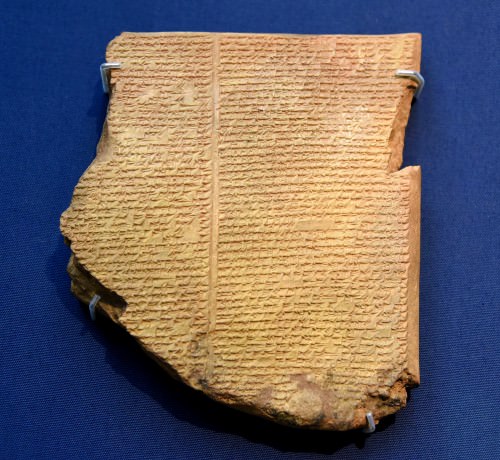
Flood Tablet of the Epic of Gilgamesh
Prior to the mid-19th century CE, the Bible was considered the oldest book in the world and the stories it contained were thought to be original pieces written by God or God-inspired. After archaeological digs in the region of the Fertile Crescent, however, and the discovery of the Sumerian civilization, it became clear that biblical narratives were derived from earlier Mesopotamian works. Mesopotamian religion and literature, in fact, would inspire and inform that of many other later cultures.
CHANGING EMPIRES
The region changed hands many times through the ages. By 912 BCE the Assyrians controlled the Fertile Crescent and developed their vast empire. The Neo-Assyrian Empire was ruled by some of the best-known kings from antiquity including Tiglath Pileser III (745-727 BCE), Sargon II (722-705 BCE), Sennacherib (705-681 BCE), Esarhaddon (681-669 BCE) and Ashurbanipal (668-627 BCE). Ashurbanipal prized knowledge highly and ordered all the literary works of the region copied and stored in his great library.
When the Neo-Assyrian Empire fell in 612 BCE, the invading forces set fire to the libraries of the cities but, since the works were written on clay tablets, they were only baked harder, not destroyed. The invaders, inadvertently, were responsible for the preservation of the very culture they sought to destroy.
By 580 BCE, the Neo-Babylonian Chaldean Empire under Nebuchadnezzar II (634-562 BCE) was in power and Babylon flourished as the greatest city on earth. Allegedly, at this time, Nebuchadnezzar had the famous Hanging Gardens of Babylon created for his wife to remind her of her homeland. In 539 BCE Babylon fell to Cyrus the Great (d. 530 BCE) after the Battleof Opis and the lands fell under the control of the Achaemenid Empire, also known as The First Persian Empire.
Alexander the Great invaded the area in 334 BCE and, after him, it was ruled by the Parthians, among others, until the coming of Rome in 116 CE. After the short-lived Roman annexation and occupation, the region was conquered by the Sassanid Persians (c. 226 CE) and, finally, by the Arabian Muslims in the 7th century CE.
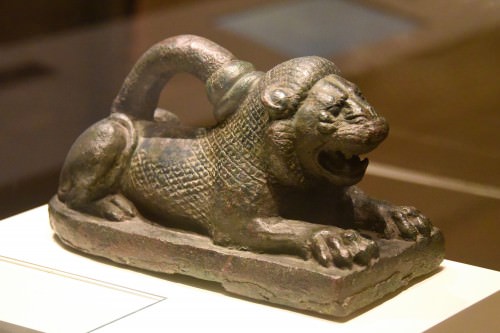
Achaemenid Lion Weight
By this time the glorious achievements of the early cities which grew up beside the Tigris and Euphrates Rivers had long been disseminated throughout the ancient world but the cities themselves were mostly in ruins through the destruction caused by the many military conquests in the region as well as natural causes such as earthquakes and fire. Rampant urbanization and the over-use of the land also resulted in the decline and eventual abandonment of the cities of the Fertile Crescent.
BABYLON'S NAME WOULD FOREVER BE LINKED TO SIN & CORRUPTION BY THE LATER HEBREW SCRIBES.
The city of Eridu, considered by the early Mesopotamians to be the first city on earth, built and inhabited by the gods, had been abandoned since 600 BCE, Uruk, the city of Gilgamesh, since 630 CE and Babylon, the city known for high culture, writing, law, science, and all manner of learning in the ancient world was a vacant ruin. Babylon's name would forever be linked to sin and corruption by the later Hebrew scribes who wrote the biblical narratives but, in its time, was greatly respected as a center of learning and civilization.
THE FERTILE CRESCENT TODAY
In 2001 CE the National Geographic News reported that the Fertile Crescent was rapidly becoming so only in name as, due to extensive damming of the rivers as well as a massive draining works program initiated in southern Iraq from the 1970's CE on, the fertile marshlands which once covered 15,000 – 20,000 square kilometers (5,800 – 7,700 square miles) had shrunk to a mere 1,500 – 2,000 square kilometers (580 – 770 square miles).
As pleas from environmental groups and regional farmers to stop damming and drainage projects were ignored by the governments of Iraq, Syria, and Turkey, the situation worsened so that, presently, the region which once was the lush paradise and cradle of civilization largely consists of dry, cracked plains of sun-baked clay.
Even after continued, long-term, threats to the environment were made clear to the governments of the region, no substantial efforts were made to preserve the land or reverse the damage. It has been observed by many scholars, historians, environmentalists, and writers through the centuries that human beings fail to learn from their pasts - whether individually or collectively. The philosopher George Santayana famously noted that "those who cannot remember the past are condemned to repeat it" and this paradigm rings as true for the Fertile Crescent as it does for any other region in the world today.
Byzantine-Armenian Relations › Origins&
Ancient Civilizations
The relationship between the Byzantine Empire and ancient Armenia was a constant and varied one with an equal mix of wars, occupations, treaties of friendship, mutual military aid, and cultural exchange. Regarded as a vital defence to the Empire’s eastern frontiers, emperors used various means of influence from outright takeover to gifts of titles and lands to Armenian nobles. Influence went in the other direction, too, with several important Byzantine emperors being of Armenian descent, as well as many individuals who held key military and administrative positions in Constantinople and beyond.

Byzantine Empire c. 626 CE
SOURCES
There are several difficulties in assessing the relations between Byzantium and ancient Armenia. Aside from the usual problem of ancient historical sources having an inherent bias towards rulers, noble families, and high politics, account must be taken of the shifting geographical location of Armenia over the centuries and its regular division and redivision by successive empires in the region. There are problems, too, with primary sources which can be coloured by nationalism and left incomplete with deliberate omissions. There are also long silences in the historical record, notably from 730 to 850 CE and 925 to 980 CE.Nevertheless, a reasonable picture of relations between the two states can be drawn and the historian TW Greenwood, by way of a summary, highlights three stand-out features of this relationship:
In the first place, relation were continuous…Secondly, they were multi-layered…it seems very likely that lesser lords and individual bishops were also in contact with Byzantium throughout…Thirdly, they were reciprocal.Byzantium was eager to secure its eastern flank and therefore sought to attract Armenian clients into its service.At the same time Armenian princes looked to Byzantium to bolster their own status within Armenia through the concession of titles, gifts and money…It is no coincidence that the Byzantine army - and then the state - came to be filled with men of Armenian origin or descent. (Shepard, 363-4)
A STRATEGIC POSITION
Ancient Armenia, because of its geographical location and strategic importance in controlling access to Mesopotamia from Asia Minor (and vice versa), had long been a coveted chunk of territory for the empires who dominated the region at any particular time. Whoever controlled the Armenian plain of Ararat could then launch an army to attack either east or west. This situation had not changed by the 4th century CE and the rise of the Byzantine Empire with its capital at Constantinople.Byzantium's first opponent and territorial rival was the Sassanid Empire in Persia (224-651 CE). From 252 CE the Sasanids became more ambitious to rule directly over Armenia and made attacks on several cities. Byzantium, defending the status quo, opposed such incursions.
THEODOSIUS I & SHAPUR III AGREED TO FORMALLY DIVIDE ARMENIA BETWEEN THE BYZANTINE EMPIRE & SASANID PERSIA.
There followed a century of wrangling over control of Armenia, which came to the boil when Shapur II, the Sasanid ruler (r. 309-379 CE), attacked Armenia in 368 and 369 CE, destroying several cities. A decade later, emperor Theodosius I (r. 379-395 CE) and Shapur III (r. 383-388 CE) agreed to formally divide Armenia between the Byzantine Empire and Sasanid Persia.Henceforth, the Roman -controlled part of Armenia now largely fades from the historical view with only sporadic returns whenever it suited Byzantine historians.
PERSIAN ARMENIA
To clarify Byzantium's relationship with their part of Armenia, it is perhaps useful to first look over the diplomatic fence at the Persian side. Persia installed marzpan (viceroy) rulers in their half of the country (Persarmenia) from 428 CE in a system that would endure until c. 651 CE. Representing the Sasanian king, the marzpan had full civilian and military authority. There had been rumblings of discontent amongst the Armenian nobility and clergy following Persian cultural imperialism, but matters really came to a head with the succession of the Persian king Yazdgird (Yazdagerd) II in c. 439 CE. Sasanid rulers had long been suspicious that Armenian Christians were all simply spies of Byzantium, but Yazdgird was a zealous proponent of Zoroastrianism, and the double-edged sword of political and religious policy was intended to cut Armenia down to size.

Battle of Avarayr
In May or June 451 CE at the Battle of Avarayr (Avarair) in modern Iran, the Armenians rebelled against oppression and faced a massive Persian army. The 6,000 or so Armenians were led by Vardan Mamikonian, but unfortunately for them, help from the Christian Byzantine Empire was not forthcoming despite an embassy sent for that purpose. Perhaps not unexpectedly, the Persian-backed marzpan, Vasak Siuni, was nowhere to be seen in the battle either. The Persians, greatly outnumbering their opponents and fielding an elite corps of “Immortals” and a host of war elephants, won the battle easily enough and massacred their opponents; 'martyred' would be the term used by the Armenian Church thereafter. Indeed, the battle became a symbol of resistance with Vardan, who died on the battlefield, even being made a saint.
BYZANTINE ARMENIA
Meanwhile, from 387 CE, the Byzantines had divided their portion of Armenia into two areas: Armenia I in the north and Armenia II in the south. Each area had a governor ( praeses ) who was in turn responsible to the governor ( vicar ) of the imperial administrative district or diocese of Pontus, who was himself responsible to the Praetorian Prefect of the East. Aside from paying taxes and performing military service for Byzantium, the control from Constantinople was light, although one legion and extra cavalry units were permanently stationed in each area. The bureaucracy of the empire in the two regions was filled with members of the Armenian nobility but, at least administratively, Armenia was fully absorbed into the Byzantine Empire.
From the 5th century CE, some cities were especially prosperous, notably Artashat, which became an important trading point between the Byzantine and Persian Empires. In 536 CE, when the Byzantine emperor Justinian I reorganised the administration of the region, Armenia was split into four areas or provinces (Armenia I- IV), each with its own capital. Byzantine laws began to be embedded more deeply into Armenian society, too, especially in such areas as inheritance. Previously, Armenian nobles had passed on their land to their sons (or brother if they had none) with daughters being ineligible to inherit.Justinian changed this so that women could legally inherit their parent's property. Rather than a move for women's rights, the change in law was designed to weaken the stranglehold of traditional Armenian clans on landed estates as now women could pass on the family property to their husbands who could be outside the clan structure or even foreigners. There was resistance to the changes from some clans - the governor of Armenia I was murdered in one uprising in 538 CE - but ultimately they did not have the political power to prevent them and those who continued to resist were deported, especially to the Balkans.
THERE WAS A SPLIT AMONGST THE ARMENIAN NOBILITY AS SOME CLANS SUPPORTED PERSIA WHILE OTHERS FAVOURED BYZANTIUM.
Artashat's continued prosperity is evidenced by an edict of 562 CE which confirmed the city as one of only three official trading points between the Byzantine and Persian Empires. A customs post there was overseen by officials known as “commercial counts” or comites commercium. By the end of the 6th century CE Armenia was again a point of dispute between Persia and the Byzantine Empire, and so a redivision was drawn up in 591 CE, which saw Byzantium acquire two-thirds of Armenia.Under the new agreement, the important city and former capital of Dvin became a frontier city between the two spheres of influence and, as a result, disputed territory. Inside Armenia, too, there was a split amongst the nobility as some clans supported Persia (eg the Bagratuni) while others favoured Byzantium (eg the Mamikonians).
A Byzantine army of emperor Heraclius (r. 610-641 CE) attacked Dvin in 623 CE. Worse was soon to come, though. In 627 CE a full-scale war against the Sasanids was carried out by Heraclius and Armenia was caught in the crossfire. This campaign ended the Sassanid control of Armenia but Byzantine rule was to be short-lived following the dramatic rise of a new power in the region, the Arab Umayyad Caliphate, which conquered the Sasanid capital Ctesiphon in 637 CE. Armenia was conquered by the Arabs from Damascus from 640 CE. The Byzantine emperors had not given up on Armenia, and in 642 CE, Constans II (641-668 CE) attacked Dvin but without success. By 670 CE, after decades of playing, as so often before, the role of strategic pawn in a battle of Empires between the Arabs and the Byzantine Empire, Armenia was made a province of the Umayyad Caliphate.

Umayyad Conquest, 7th & 8th Centuries CE
MANZIKERT & THE UMAYYAD CALIPHATE
Byzantine emperor Constantine V (r. 741-775 CE) attacked Armenia between 746 and 752 CE, taking advantage of the civil war which preoccupied the Umayyad Caliphate. The Byzantine Empire would assert even more influence over Armenia from the 10th century CE. Notable events include the Byzantines helping the Bagratuni establish their kingdom in 914 CE, the invasion of emperor John Tzimiskes in 974 CE, the annexation of the province of Tayk in 1000 CE, the capture of the Armenian capital Ani and fall of the Bagratuni kingdom in 1074 CE, and the seizure of Kars in 1065 CE.
In August 1071 CE there was the momentous Battle of Manzikert. Fought north of Lake Van on Armenian soil between the armies of the Byzantine Empire and Seljuk Turks (a nomadic tribe of the Asian steppe), the battle was one of the worst defeats the Byzantines had ever suffered, if not in numbers then at least in terms of psychology. The victorious Seljuk army captured the Byzantine emperor Romanos IV Diogenes (r. 1068-1071 CE), and, with the empire in disarray as generals squabbled for the throne, nothing could stop them sweeping across Asia Minor. The Byzantine Empire would go on for a few more centuries yet but Manzikert is seen by many historians as the beginning of a long and seemingly unstoppable decline.
Throughout the 12 century CE, Armenia and Byzantium squabbled over the Cilician plain and its various cities. Several Crusader armies passed through Armenia, and then another group of unwanted visitors, this time even more ruthlessly destructive ones, ravaged the region: the Mongols, who attacked in 1236 CE and caused a mass-migration of Armenians to Russia and the Crimea.
ARMENIAN BYZANTINE EMPERORS
There were several notable Byzantine emperors actually of Armenian descent as the dynasties of Constantinople came and went with usurpers grabbing their opportunities to oust the incumbent emperor. This was particularly so from the 9th century CE when military threats to the empire ensured that an emperor could be deposed if he proved incapable on the battlefield.One such figure was Leo V the Armenian, who ruled in Constantinople from 813 to 820 CE. Of humble origins, Leo rose the ranks of the Byzantine army to eventually become the strategos or military governor of the province of Anatolikon, the most important region of Asia Minor. When the Bulgar army looked set to attack Constantinople in June 813 CE, the reigning and incompetent emperor Michael I Rangabe (r. 811-813 CE) was ousted and the people looked to Leo to save the day. Paying off the Bulgars with a huge ransom in gold, Leo V did indeed save the city. His glory was short-lived, for just seven years later the emperor lost his throne to his former friend and ally Michael II (r. 820-829 CE) in one of those typical episodes of violence which plagued Byzantine politics. Murdered in church, Leo's body was dragged around the Hippodrome of Constantinople for the public to scorn and ridicule.
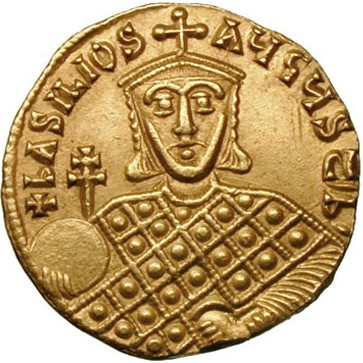
Basil I
Perhaps the most famous Armenian emperor, or more correctly, infamous, was Basil I (r. 867-886 CE). Basil was an Armenian peasant, who, through his friendship with the emperor Michael III (r. 842-867 CE) rose to prominence at court. Basil was ambitious, though, and he murdered his benefactor to take the throne for himself in 867 CE. Strengthening and modernising the Byzantine navy, Basil's reign saw several notable victories and expansion in the Mediterranean and Asia Minor. Basil also embarked on a massive rebuilding programme in Constantinople and a major overhaul of Byzantine law. His reign would later be regarded as a Golden era, but the emperor lost his throne just as violently as he had gained it - murder disguised as an unlikely hunting accident probably arranged by his successor, Leo VI (r. 886-912 CE).
FROM THE 6TH CENTURY CE, ARMENIANS RELOCATED TO MANY OTHER PARTS OF THE BYZANTINE EMPIRE & ESPECIALLY CONSTANTINOPLE.
A third notable Armenian on the Byzantine throne was Romanos I Lekapenos (r. 920-944 CE). Another successful emperor, he, like Leo V, had risen through the military ranks to become commander of the imperial fleet in 912 CE. Also like Leo, Romanos took the throne by force after the Bulgars proved the undoing of his predecessors. Easing his way into palace affairs, Romanos first made himself regent for the young Constantine VII in 919 CE and then, declaring himself emperor one year later, he married his daughter to the legitimate emperor for good measure. Once in power, Romanos proved worthy of the position and he reconciled the various factions of the Byzantine Church, made significant land reforms to protect poorer farmers, there was a peace brokered with the Bulgars and, with the gifted general John Kourkouas leading the army, significant victories in Asia Minor against the Arabs. The Rus Vikings did attack Constantinople in 941 CE but the city's Theodosian Walls did their job, and the raiders were repelled. When Romanos died, the throne was returned to the legitimate line but, once again, he had shown that foreigners could rule just as well or badly as those emperors of true Byzantine descent.
ARMENIAN-BYZANTINE CHURCH RELATIONS
Another area, besides politics, rulers, and administrators, which connected Byzantium and Armenia was religion. Armenia's zeal for Christianity, the religion being officially adopted around 314 CE, did bring it closer to the Byzantine Empire, Constantinople being the head of the Christian church in the East. However, the Armenian and Byzantine churches did often differ on matters of dogma. Disagreement with the decrees of the Council of Chalcedon in 451 CE opened a rift which would never be closed. Then the Council of Dvin c. 554 CE declared the Armenian Church's adherence to the doctrine of monophysitism (that Christ has one nature and not two) thus breaking away from the duophysitism of the Roman Church. As in politics, Armenian Christians were having to find their own rocky road between East and West as the Armenian church broke away from Constantinople in the mid-7th century CE.
CULTURAL EXCHANGE
From the 6th century CE, Armenians relocated to many other parts of the Byzantine Empire and especially Constantinople.They were perhaps the most assimilated of any ethnic group, although they maintained their own language, literature, art, and religious practices. Armenian traders, scholars, military personnel of all ranks, and mercenaries became part and parcel of Byzantine everyday life.
Where cultural innovations originally spring from is always difficult to pinpoint with accuracy, but some scholars claim that ideas in architecture and illuminated manuscripts, for example, came to Byzantium from Armenia. Indeed, the architect who famously repaired the dome of the Hagia Sophia church in Constantinople after the 989 CE earthquake, one Trdat of Ani, was an Armenian. Undoubtedly, features of Byzantine architecture (eg Greek monograms, eagle capitals, and classicising Ionic columns) travelled in the other direction, too. Ideas in art, too, were exchanged and travelled via the manufactured goods which were traded between the two powers such as those made in Armenia (textiles, glazed pottery, glassware, and metalwork) and those made in Constantinople or imported there from around the world by land and sea.
[naasr]
Pericles › Who Was
Definition and Origins

Pericles (l. 495–429 BCE) was a prominent Greek statesman, orator, and general during the Golden Age of Athens. The period in which he led Athens, in fact, has been called the Age of Pericles due to his influence, not only on his city 's fortunes, but on the whole of Greek history during the 5th century BCE and even after his death. He was a fierce proponent of democracy, although the form this took differed from the modern day as only male citizens of Athens could participate in politics. Even so, his reforms would lay the groundwork for the development of later democratic political systems.
Pericles' name means "surrounded by glory" and he would live up to his name through his efforts to make Athens the greatest of the Greek city-states. His influence on Athenian society, politics, and culture was so great that Thucydides (l. 460-395 BCE), his contemporary admirer and historian, called him "the first citizen of Athens" ( History, II.65).
Pericles' name means "surrounded by glory" and he would live up to his name through his efforts to make Athens the greatest of the Greek city-states. His influence on Athenian society, politics, and culture was so great that Thucydides (l. 460-395 BCE), his contemporary admirer and historian, called him "the first citizen of Athens" ( History, II.65).
PERICLES PROMOTED THE ARTS, LITERATURE, & PHILOSOPHY & GAVE FREE REIGN TO SOME OF THE MOST INSPIRED WRITERS, ARTISTS, & THINKERS OF HIS TIME.
Pericles promoted the arts, literature, and philosophy and gave free reign to some of the most inspired writers, artists, and thinkers of his time. He increased Athens' power through his use of the Delian League to form the Athenian empire and led his city through the First Peloponnesian War (460-446 BCE) and the first two years of the Second Peloponnesian War (431-404 BCE). He was still actively engaged in political life when he died of the plague in 429 BCE.
EARLY LIFE & RISE TO POWER
Pericles was born in Athens, in 495 BCE, to an aristocratic family. His father, Xanthippus (c. 525-475 BCE) was a respected politician and war hero and his mother, Agariste, a member of the powerful and influential Alcmaeonidae family who encouraged the early development of Athenian democracy.
Pericles' family's nobility, prestige, and wealth allowed him to pursue his inclination toward education in any subject he fancied.He read widely, showing an especial interest in philosophy, and is recognized as the first Athenian politician to attribute importance to philosophy as a practical discipline which could help guide and direct one's thought and actions rather than a mere speculative past-time or the trade of the Sophists.

Athens Acropolis
Pericles' early years were quiet and the introverted young man took to avoiding public appearances and speeches, instead preferring to devote his time to his studies. Later in life, this initial shyness would encourage the claims of his detractors that his consort Aspasia of Miletus (c. 470 - 410 BCE) taught him how to speak and wrote his speeches for him because, they said, there was no evidence of him learning oratory in his youth. It was a grave insult to a man of Athens, especially a statesman, to claim a woman was responsible for his successful career and Pericles' political enemies would focus on this charge repeatedly.
Pericles was involved in politics already in the early 460's BCE but precisely when is unknown. He prosecuted a case against his political rival Cimon (lc 510 - 450 BCE) in 463 BCE charging the latter with corruption in his dealings with Macedon.Cimon, son of Miltiades (the hero of Marathon, lc 555 - 489 BCE), was acquitted but this may have been due more to his political connections and influence than any failing on Pericles' part to prosecute the case.
Cimon was the leader of the conservative party and an able military commander who had fought at Salamis in 480 BCE when the Greeks defeated the Persians. During the Persian invasion of 480 BCE, Athens had rallied the other city-states to defense and, afterwards, assumed a dominant position. The Delian League, a confederation of the city-states, was formed in 478 BCE to provide defense against further Persian aggression and Cimon was instrumental in persuading various city-states to join.
Years before Pericles entered politics, Cimon was already influential and had done a great deal of good for the people of Athens and the other city-states. Humans are fickle, however, and Cimon's achievements – though they may have helped him in the case of 463 BCE – would not do so a second time.

Greek Warships
The conservative party supported the aristocratic political assembly of the areopagus while the democratic faction in Athens encouraged reforms in the popular assembly known as ekklesia. The leader of the democratic party was Ephialtes (5th century BCE) who was Pericles' mentor. Cimon had served as a diplomat between Athens and Sparta a number of times since 478 BCE and, in 465 BCE, led the Athenian contingent of 4,000 soldiers to aid Sparta in putting down a rebellion by helots.Sparta insulted Athens by dismissing this sizeable force while welcoming the aid of other city-states. Athens responded by breaking their diplomatic ties with Sparta.
The reason for Sparta's dismissal of the Athenian force is unknown but it has been suggested that Sparta did not trust Athens to remain loyal and feared they would switch sides during the conflict. Early accounts simply state that the Spartans did not like the look of Cimon's soldiers.
Whatever the reason was, in 461 BCE Pericles again charged Cimon with corruption – this time by claiming he was aiding Spartan interests – and succeeded in having his rival ostracized from the city for ten years. Shortly afterwards in the same year, Ephialtes was assassinated; these two events mark the beginning of Pericles' rise to power.
DURING THE AGE OF PERICLES, ATHENS BLOSSOMED AS A CENTER OF EDUCATION, ART, CULTURE, & DEMOCRACY.
THE FIRST PELOPONNESIAN WAR
The Delian League had existed for almost twenty years at this time and had increasingly become more of an extension of Athenian power and politics than a Greek confederacy for mutual defense. City-states preferred to simply pay Athens to defend them rather than send troops and supplies for the common cause and this penchant – which Athens welcomed - made the city rich and powerful.
Historian Edith Hamilton elaborates:
Back in 480, after the final defeat of the Persians, the Athenians had been chosen to lead the new confederacy of free Greek states. It was a lofty post and they were proud to hold it, but the role demanded a high degree of disinterestedness. Athens could be the leader of the free only if she considered the welfare of others on the same level with her own. During the war with Persia she had been able to do that…As head of the league, too, for a time she had not let her power corrupt her. But only for a short time. The temptation to acquire still more power proved as always irresistible. Very soon the free confederacy was being turned into the Athenian Empire.(117)
The First Peloponnesian War was fought between Athens and Sparta for supremacy although the actual conflict would primarily involve Athens and Corinth, an ally of Sparta. Greece was not a united country at this time but a confederacy of city-states bound together through “shared blood, shared language, shared religion, and shared customs” ( Herodotus as cited in Boardman, 127). Certain city-states would align themselves with either Athens or Sparta, the two most powerful, depending on self-interest and this created the web of alliances which would form the opposing sides of the war.

Delian League
Sparta feared that Athens' growing power was a threat but could not hope to defeat the Athenian navy which had only become larger and more effective since the victory at Salamis in 480 BCE. Corinth, however, had a fleet and so did another ally, Aegina, which the Spartan coalition made use of. Although these alliances – as well as the helot revolt and the Spartan insult to Athens - are commonly cited as the source of the conflict, Edith Hamilton expands on these claims:
The real cause of the war was not this or that trivial disturbance, the revolt of a distant colony, the breaking of an unimportant treaty, or the like. It was something far beneath the surface, deep down in human nature, and the cause of all the wars ever fought. The motive power was greed, that strange passion for power and possession which no power and no possession satisfy. Power, or its equivalent wealth, created the desire for more power, more wealth. The Athenians and the Spartans fought for one reason only – because they were powerful and therefore were compelled to seek more power. (114)
Pericles, as commander-in-chief, led the Athenian forces in a number of battles but neither side could gain a significant advantage. A truce was finally agreed to, orchestrated by Cimon, who returned from his exile in 451 BCE and served as intermediary on Pericles' behalf. The truce allowed Pericles to focus his attention on other areas. He issued his so-called Congress Decree in 449 BCE inviting all the city-states to gather for talks on a unified country but when Sparta refused to attend, the initiative stalled. Hostilities were not resumed, however, and the First Peloponnesian War concluded with a treaty which established limits to the reach of both Athens and Sparta.
ASPASIA & THE FUNERAL ORATION
Throughout the war, Pericles was engaged in various cultural initiatives in Athens which brought him into regular contact with the leading intellectuals of the city. Among these was the foreign-born writer and teacher Aspasia of Miletus and, in 445 BCE, he divorced his wife (name unknown) and began (or continued) a romantic relationship with Aspasia. Aspasia's talent as a writer, and close association with Pericles, encouraged his enemies to claim she was the author of his greatest speeches but it seems clear he had a gift for oratory from a young age, long before he met her, as evidenced in speeches such as the one which exiled Cimon.
PERICLES' FUNERAL ORATION HIGHLIGHTS HOW ATHENIAN DEMOCRACY ENCOURAGES PERSONAL FREEDOM & SETS THE CITY APART FROM THE REST.
The most famous of these speeches is his Funeral Oration, given at the conclusion of the First Peloponnesian War. In this work, Pericles praises the soldiers who fell in battle, the bravery of their Athenian ancestors, the families who sacrificed loved ones for the city, and encourages survivors to honor the memory of the fallen. His primary focus, however, is the glory of Athens and how unique it is among all the other cities of the world. The speech, recorded by Thucydides, highlights how Athenian democracy encourages personal freedom and sets the city apart from the rest as an example to all:
Our constitution does not copy the laws of neighboring states; we are rather a pattern to others than imitators ourselves. Its administration favours the many instead of the few; this is why it is called a democracy. If we look to the laws, they afford equal justice to all in their private differences; if no social standing, advancement in public life falls to reputation for capacity, class considerations not being allowed to interfere with merit; nor again does poverty bar the way, if a man is able to serve the state, he is not hindered by the obscurity of his condition. The freedom which we enjoy in our government extends also to our ordinary life. There, far from exercising a jealous surveillance over each other, we do not feel called upon to be angry with our neighbor for doing what he likes, or even to indulge in those injurious looks which cannot fail to be offensive, although they inflict no positive penalty.But all this case in our private relations does not make us lawless as citizens. Against this fear is our chief safeguard, teaching us to obey the magistrates and the laws, particularly such as regard the protection of the injured, whether they are actually on the statute book, or belong to that code which, although unwritten, yet cannot be broken without acknowledged disgrace. ( History, II.34-46)
Although certainly an idealized vision of Athens, Pericles' speech continues to resonate in its advocacy for a free and democratic state and the benefits such a system offers. Throughout the work, he emphasizes how the city has been able to achieve its greatness through the freedom of thought and expression of the people. Although democracy was developing in Athens long before Pericles, his initiatives allowed it to flourish and, as it did, so did Athenian culture.
CULTURAL ACHIEVEMENTS
During the Age of Pericles, Athens blossomed as a center of education, art, culture, and democracy. Artists and sculptors, playwrights and poets, architects and philosophers all found Athens an exciting and enlivening atmosphere for their work.Athens under Pericles saw the construction of the Acropolis and the glory of the Parthenon, begun in 447 BCE. The painter Polygnotus (5th century BCE) created his famous works which were later immortalized by Pausanias (c. 110 - 180 CE).
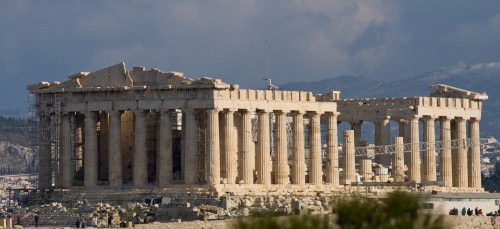
The Parthenon
Playwrights Aeschylus (c. 525 - c. 456 BCE), Sophocles (c. 496 - c. 406 BCE), Euripides (c. 484 - 407 BCE), and Aristophanes (c. 460 - c. 380 BCE) - in short, all of the great Greek writers for the stage - invented theater as it is known in the modern-day. Hippocrates (c. 460 - c. 370 BCE), who inspired the Hippocratic Oath still taken by physicians today, practiced medicine at Athens while Herodotus (c. 484 - 425/413 BCE), the Father of History, traveled and wrote his famous work.
Great sculptors like Phidias (c. 480 - c. 4430 BCE), who created the statue of Zeus at Olympia (considered one of the Seven Wonders of the Ancient World), as well as the statue of Athena Parthenos for the Parthenon worked at his craft and Myron (c. 480 - c. 440 BCE) the sculptor produced his masterpiece known as the Discus Thrower.
The great philosophers Protagoras (c. 485 - c. 415 BCE) Zeno of Elea (c. 465 BCE), and Anaxagoras (c. 500 - c. 428 BCE) were all personal friends of Pericles. Anaxagoras, in fact, is said to have influenced Pericles' public demeanor and acceptance of fate, especially after the death of Pericles' sons from plague. Socrates (c. 470/469 - 399 BCE), the founder of western philosophy, also lived and taught in Athens during this period and his students – most notably Plato (428/427 - 348/347 BCE) – would go on to found their own philosophical schools and change western thought forever.
THE SECOND PELOPONNESIAN WAR & DEATH
The Age of Pericles, however, could not last any more than any other in history. At the beginning of 431 BCE Athens entered into the Second Peloponnesian War with Sparta which would end in Athens' defeat; but Pericles would not live to see the fall of his city. In his Funeral Oration, Pericles said that, “Grief is felt not so much for the want of what we have never known as for the loss of that to which we have been long accustomed” ( History, II.43). The Athenians present at the speech would certainly have keenly felt this particular line in reference to those they had lost but, by the end of the second war with Sparta, his words would no doubt have resonated even more as Athens lost everything it had worked so hard for.
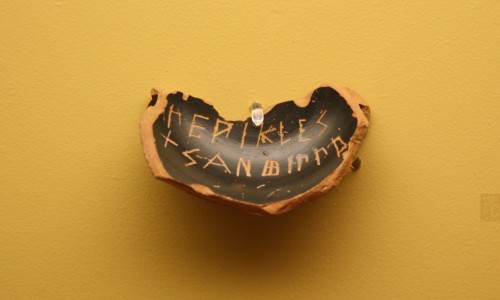
Ostrakon for Pericles
Soon after the war began, the great leader who had directed the city through the first conflict died in 429 BCE; the plague struck the city and Pericles was among its victims. Bereft of his leadership, the Athenians made mistake after mistake in their military decisions leading eventually to their defeat by the Spartans in 404 BCE, the destruction of their city's walls, and their occupation and rule by Sparta.
In his History of the Peloponnesian War, Thucydides makes clear what a disaster Pericles' death was for Athens in that those who came after him desired to be popular rather than effective and, in so doing, doomed the city to ruin. Even though Thucydides admired and supported Pericles, there is no reason to conclude that his claims are simply a form of bias. History bears out Thucydides' view in that, with the death of Pericles, Athens fell into an intellectual, cultural, and spiritual darkness which the Athenians would struggle with over the next 30 years, culminating in the execution of Socrates in 399 BCE.
Although Pericles has been criticized as a “populist” who appealed to the baser instincts of the people, as well as a war-monger who encouraged both wars with Sparta, he quite obviously was able to create an atmosphere of freedom of thought and expression which resulted in some of the greatest contributions to world culture ever made.
The period of Greek history in which he lived and reigned is rightly known as the Age of Pericles because his initiatives allowed that age to flourish. Even at war, Pericles was able to maintain the social stability necessary for art, literature, and philosophy to flourish and the works of this age continue to influence and inspire in the present day.
LICENSE:
Article based on information obtained from these sources:with permission from the Website Ancient History Encyclopedia
Content is available under License Creative Commons: Attribution-NonCommercial-ShareAlike 3.0 Unported. CC-BY-NC-SA License